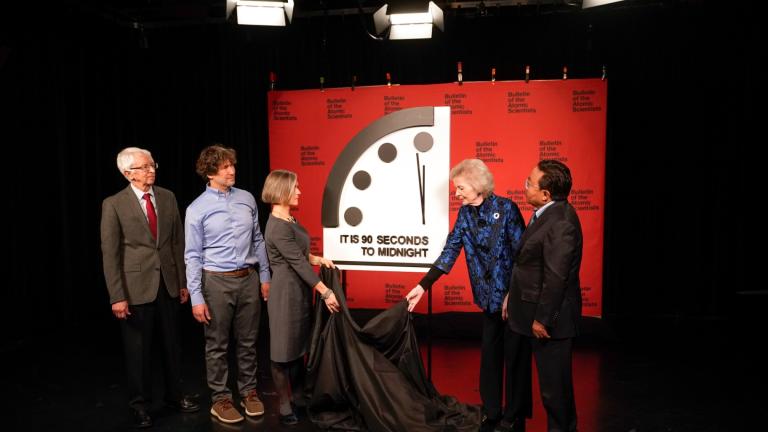The new year is not starting off well if you're hoping to avoid global apocalypse. The so-called Doomsday Clock just moved one minute closer to midnight. It was at 11:54 pm and now stands at 11:55 pm. Midnight is the symbolic hour that earth faces annihilation.
The clock originated at the University of Chicago right after World War II as the nuclear age began. But in recent years, the clock's meaning has been expanded to include other major global threats. Kennette Benedict, Executive Director and Publisher of the Bulletin of the Atomic Scientists at the U of C, joins us on Chicago Tonight at 7:00 pm to explain the phenomenon.
Doomsday Clock Timeline
January 1, 2012IT IS 6 MINUTES TO MIDNIGHT
2010: "We are poised to bend the arc of history toward a world free of nuclear
weapons" is the Bulletin's Assessment. Talks between Washington and Moscow for a
follow-on agreement to the Strategic Arms Reduction Treaty are nearly complete, and more
negotiations for further reductions in the U.S. and Russian nuclear arsenal are already
planned. The dangers posed by climate change are growing, but there are pockets of
progress. Most notably, at Copenhagen, the developing and industrialized countries agree to
take responsibility for carbon emissions and to limit global temperature rise to 2 degrees
Celsius.IT IS 5 MINUTES TO MIDNIGHT
2007: The world stands at the brink of a second nuclear age. The United States and
Russia remain ready to stage a nuclear attack within minutes, North Korea conducts a
nuclear test, and many in the international community worry that Iran plans to acquire the
Bomb. Climate change also presents a dire challenge to humanity. Damage to ecosystems is
already taking place; flooding, destructive storms, increased drought, and polar ice melt are
causing loss of life and property.
IT IS 7 MINUTES TO MIDNIGHT
2002: Concerns regarding a nuclear terrorist attack underscore the enormous
amount of unsecured--and sometimes unaccounted for--weapon-grade nuclear materials
located throughout the world. Meanwhile, the United States expresses a desire to design
new nuclear weapons, with an emphasis on those able to destroy hardened and deeply
buried targets. It also rejects a series of arms control treaties and announces it will
withdraw from the Anti-Ballistic Missile Treaty.IT IS 9 MINUTES TO MIDNIGHT
1998: India and Pakistan stage nuclear weapons tests only three weeks apart. "The
tests are a symptom of the failure of the international community to fully commit itself to
control the spread of nuclear weapons--and to work toward substantial reductions in the
numbers of these weapons," a dismayed Bulletin reports. Russia and the United States
continue to serve as poor examples to the rest of the world. Together, they still maintain
7,000 warheads ready to fire at each other within 15 minutes.IT IS 14 MINUTES TO MIDNIGHT
1995: Hopes for a large post-Cold War peace dividend and a renouncing of nuclear
weapons fade. Particularly in the United States, hard-liners seem reluctant to soften their
rhetoric or actions, as they claim that a resurgent Russia could provide as much of a threat
as the Soviet Union. Such talk slows the rollback in global nuclear forces; more than 40,000
nuclear weapons remain worldwide. There is also concern that terrorists could exploit
poorly secured nuclear facilities in the former Soviet Union.IT IS 17 MINUTES TO MIDNIGHT
1991: With the Cold War officially over, the United States and Russia begin making
deep cuts to their nuclear arsenals. The Strategic Arms Reduction Treaty greatly reduces
the number of strategic nuclear weapons deployed by the two former adversaries. Better
still, a series of unilateral initiatives remove most of the intercontinental ballistic missiles
and bombers in both countries from hair-trigger alert. "The illusion that tens of thousands
of nuclear weapons are a guarantor of national security has been stripped away," the
Bulletin declares.IT IS 10 MINUTES TO MIDNIGHT
1990: As one Eastern European country after another (Poland, Czechoslovakia,
Hungary, Romania) frees itself from Soviet control, Soviet General Secretary Mikhail
Gorbachev refuses to intervene, halting the ideological battle for Europe and significantly
diminishing the risk of all-out nuclear war. In late 1989, the Berlin Wall falls, symbolically
ending the Cold War. "Forty-four years after Winston Churchill's 'Iron Curtain' speech, the
myth of monolithic communism has been shattered for all to see," the Bulletin proclaims.IT IS 6 MINUTES TO MIDNIGHT
1988: The United States and Soviet Union sign the historic Intermediate-Range
Nuclear Forces Treaty, the first agreement to actually ban a whole category of nuclear
weapons. The leadership shown by President Ronald Reagan and Soviet Premier Mikhail
Gorbachev makes the treaty a reality, but public opposition to U.S. nuclear weapons in
Western Europe inspires it. For years, such intermediate-range missiles had kept Western
Europe in the crosshairs of the two superpowers.IT IS 3 MINUTES TO MIDNIGHT
1984: U.S.-Soviet relations reach their iciest point in decades. Dialogue between the
two superpowers virtually stops. "Every channel of communications has been constricted
or shut down; every form of contact has been attenuated or cut off. And arms control
negotiations have been reduced to a species of propaganda," a concerned Bulletin informs
readers. The United States seems to flout the few arms control agreements in place by
seeking an expansive, space-based anti-ballistic missile capability, raising worries that a
new arms race will begin.IT IS 4 MINUTES TO MIDNIGHT
1981: The Soviet invasion of Afghanistan hardens the U.S. nuclear posture. Before he
leaves office, President Jimmy Carter pulls the United States from the Olympics Games in
Moscow and considers ways in which the United States could win a nuclear war. The
rhetoric only intensifies with the election of Ronald Reagan as president. Reagan scraps any
talk of arms control and proposes that the best way to end the Cold War is for the United
States to win it.IT IS 7 MINUTES TO MIDNIGHT
1980: Thirty-five years after the start of the nuclear age and after some promising
disarmament gains, the United States and the Soviet Union still view nuclear weapons as an
integral component of their national security. This stalled progress discourages the Bulletin:
"[The Soviet Union and United States have] been behaving like what may best be described
as 'nucleoholics'--drunks who continue to insist that the drink being consumed is positively
'the last one,' but who can always find a good excuse for 'just one more round.'"IT IS 9 MINUTES TO MIDNIGHT
1974: South Asia gets the Bomb, as India tests its first nuclear device. And any gains
in previous arms control agreements seem like a mirage. The United States and Soviet
Union appear to be modernizing their nuclear forces, not reducing them. Thanks to the
deployment of multiple independently targetable reentry vehicles (MIRV), both countries
can now load their intercontinental ballistic missiles with more nuclear warheads than
before.IT IS 12 MINUTES TO MIDNIGHT
1972: The United States and Soviet Union attempt to curb the race for nuclear
superiority by signing the Strategic Arms Limitation Treaty (SALT) and the Anti-Ballistic
Missile (ABM) Treaty. The two treaties force a nuclear parity of sorts. SALT limits the
number of ballistic missile launchers either country can possess, and the ABM Treaty stops
an arms race in defensive weaponry from developing.IT IS 10 MINUTES TO MIDNIGHT
1969: Nearly all of the world's nations come together to sign the Nuclear Non-
Proliferation Treaty. The deal is simple--the nuclear weapon states vow to help the treaty's
non-nuclear weapon signatories develop nuclear power if they promise to forego producing
nuclear weapons. The nuclear weapon states also pledge to abolish their own arsenals when
political conditions allow for it. Although Israel, India, and Pakistan refuse to sign the
treaty, the Bulletin is cautiously optimistic: "The great powers have made the first step.
They must proceed without delay to the next one--the dismantling, gradually, of their own
oversized military establishments."IT IS 7 MINUTES TO MIDNIGHT
1968: Regional wars rage. U.S. involvement in Vietnam intensifies, India and Pakistan
battle in 1965, and Israel and its Arab neighbors renew hostilities in 1967. Worse yet, France
and China develop nuclear weapons to assert themselves as global players. "There is little
reason to feel sanguine about the future of our society on the world scale," the Bulletin
laments. "There is a mass revulsion against war, yes; but no sign of conscious intellectual
leadership in a rebellion against the deadly heritage of international anarchy."IT IS 12 MINUTES TO MIDNIGHT
1963: After a decade of almost non-stop nuclear tests, the United States and Soviet
Union sign the Partial Test Ban Treaty, which ends all atmospheric nuclear testing. While it
does not outlaw underground testing, the treaty represents progress in at least slowing the
arms race. It also signals awareness among the Soviets and United States that they need to
work together to prevent nuclear annihilation.IT IS 7 MINUTES TO MIDNIGHT
1960: Political actions belie the tough talk of "massive retaliation." For the first time,
the United States and Soviet Union appear eager to avoid direct confrontation in regional
conflicts such as the 1956 Egyptian-Israeli dispute. Joint projects that build trust and
constructive dialogue between third parties also quell diplomatic hostilities. Scientists
initiate many of these measures, helping establish the International Geophysical Year, a
series of coordinated, worldwide scientific observations, and the Pugwash Conferences,
which allow Soviet and American scientists to interact.IT IS 2 MINUTES TO MIDNIGHT
1953: After much debate, the United States decides to pursue the hydrogen bomb, a
weapon far more powerful than any atomic bomb. In October 1952, the United States tests
its first thermonuclear device, obliterating a Pacific Ocean islet in the process; nine months
later, the Soviets test an H-bomb of their own. "The hands of the Clock of Doom have
moved again," the Bulletin announces. "Only a few more swings of the pendulum, and, from
Moscow to Chicago, atomic explosions will strike midnight for Western civilization."IT IS 3 MINUTES TO MIDNIGHT
1949: The Soviet Union denies it, but in the fall, President Harry Truman tells the
American public that the Soviets tested their first nuclear device, officially starting the arms
race. "We do not advise Americans that doomsday is near and that they can expect atomic
bombs to start falling on their heads a month or year from now," the Bulletin explains. "But
we think they have reason to be deeply alarmed and to be prepared for grave decisions."IT IS 7 MINUTES TO MIDNIGHT
1947: As the Bulletin evolves from a newsletter into a magazine, the Clock appears
on the cover for the first time. It symbolizes the urgency of the nuclear dangers that the
magazine's founders--and the broader scientific community--are trying to convey to the
public and political leaders around the world.Source: Bulletin of the Atomic Scientists








